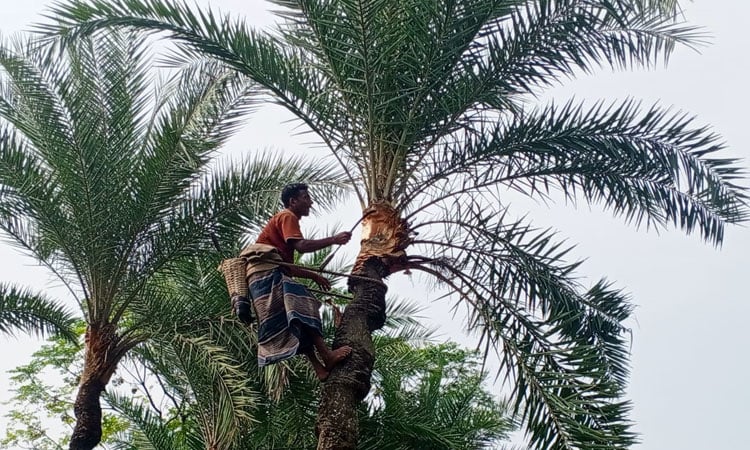District Desk
As autumn gradually gives way to winter, farmers across Chuadanga district have become busy preparing approximately 2.7 lakh date palm trees for the upcoming sap collection season — the time that heralds the beginning of molasses production, one of rural Bengal’s most treasured winter traditions.
The mild winter breeze, dew-drenched mornings, and light fog in the air signal that the season of fresh date sap and jaggery is near. Across the district’s four upazilas, farmers are seen pruning, cleaning, and preparing their trees for tapping. Following the drying and cane installation process during the month of Kartik, sap collection activities are now progressing in full swing. Around 10,000 to 15,000 farmers are involved in this traditional seasonal occupation.
According to the Department of Agricultural Extension (DAE), Chuadanga currently has 271,960 date palm trees. On average, each tree produces between 10 and 12 kilograms of molasses. For this season, the DAE has set a production target of 2,500 metric tons of date molasses.
Local sources said that in rural areas, the arrival of winter is traditionally marked by the extraction of date sap. Farmers are currently pruning and cleaning the trees, and within a few weeks — as the cold intensifies — the collection of the sweet sap will begin. In areas where date palms grow in clusters, temporary workstations have already been established, and branches are being dried for use as fuel in molasses preparation.
Shahin Ali, a farmer from Satghari village in Chuadanga municipality, said, “We have started pruning and cleaning about 120 trees. The work of installing drains will begin in two weeks. Once pruned, a tree yields sap for three to four days, after which it must be dried again. As winter deepens, we’ll collect more sap and continue making jaggery until the month of Falgun.”
Similarly, Asadul Hossain from Gopinathpur village said, “I have prepared 40 trees this year. In ten days, we’ll start installing the drains, and sap collection should begin by the last week of November. I expect to produce around 10–12 kilograms of jaggery per tree.”
Delwar Hossain of Dhuturhat village added that he has already finished preparing 140 trees. “We will start collecting sap from the beginning of Agrahayan. If the winter is long and cold, molasses production will be good this year. We usually sell our jaggery at Sarojganj market,” he said.
Sarojganj Bazar — known as the most traditional molasses market in Chuadanga — has also geared up for the upcoming season. Farmers from across the district bring their products here, and the market has long been reputed for offering pure, high-quality molasses. Last year, molasses was sold at prices ranging between Tk 220 and Tk 280 per kilogram, while patali (solid jaggery) fetched around Tk 300 per kilogram.
Masudur Rahman Sarkar, Deputy Director of the Department of Agricultural Extension, said that the district achieved its production target last year and expects similar success this time. “If the intensity of winter increases, farmers will be able to produce better-quality molasses,” he noted.
He also advised farmers to take measures to protect the collected sap from birds and bats to maintain hygiene and ensure purity. Additionally, he warned against adulteration in jaggery production.
With favorable weather conditions and the tireless efforts of local farmers, Chuadanga’s signature winter tradition of molasses making is once again poised to bring sweetness, livelihood, and cultural flavor to rural life in the region.


